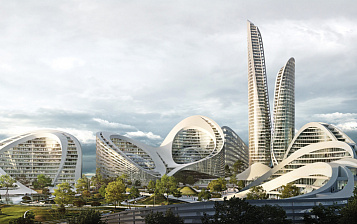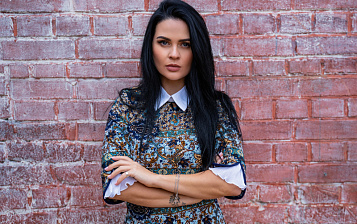The turbulent 2020 will go down in history not only for its bad weather, but also for great anniversaries, including in the field of architecture. In the last issue, we honored the memory of Zaha Hadid, who would have turned 70 in October. The same year marked the 130th anniversary of the birth of her Russian teachers - the author of horizontal skyscrapers, who related abstract painting and constructivism, El Lissitzky, and the author of smoothly twisted complex architecture, Konstantin Melnikov. At the same time, 2020 marks the 100th anniversary of the two schools that gave birth to modern architecture - the German BAUHAUS and the Soviet VKHUTEMAS. A very large exhibition dedicated to the latter opened in November at the Museum of Moscow. But this year will go down in history not only with theoretical studies of the origins of modernism, but with unprecedented practical success: despite the lockdowns, it was in 2020 that INION on Profsoyuznaya was completely restored and rebuilt in its original form - the first monument of late Soviet modernism, which was awarded such an honor. Maxim Kirsanov, special correspondent for Gorproekt magazine, listened to the arguments of the engineer and architectural historian Airat Bagautdinov, who believes that changing attitudes towards the late Soviet heritage is an opportunity to take a fresh, more positive look at the whole world around.
What to do with gray concrete boxes - destroy or love?
A terrible fire in the library of the Institute of Social Sciences in Moscow in 2015 not only deprived Russian fundamental science of hundreds of rare books, but also sharply raised the question of the preservation of monuments of late Soviet modernism, the future of which was vague. It was at that time that it was announced that the entire network of 39 Soviet modernist cinemas would be demolished by the ADG Group. Actually, a similar fate awaited INION - although the building did not burn down completely, by 2019 its remains were completely demolished, even the bridge over the long-dried artificial lake that had not been damaged initially, over which the Suprematist plate of the old library seemed to hover. But mass tastes, as it turned out, are changeable and literally recently began to shift. The habit that had prevailed for decades to reject everything Soviet finally began to give way to a more rational view of the world around, when everything that until recently was called “gray boxes” gradually ceased to be smeared with one paint, and sometimes came to life.
Perhaps the bifurcation point here was the successful reconstruction of Novy Arbat in 2016-2017, when, on the 50th anniversary of the construction of the main government highway, it turned out that with the help of modern facing materials, double-glazed windows, and most importantly, a modern approach to public spaces, an incomprehensible island of the USSR in the center of the capital has turned into an area similar to the center of Boston or the coziest parts of downtown Houston, and in some places on the "Park Avenue" of Manhattan. Many in the city did not believe in the success of adapting modernism to modern standards of urbanism so much that the destruction of several modernist pavilions at the same year at VDNKh, which they decided to return to the “Stalin era”, did not cause any resonance. Yes, and how to believe in success, when even Mikhail Posokhin, being the chief architect of the city during its heyday, half a century ago could not embody everything he wanted in it: for example, the idea of making the roof public on a single stylobate of “books”. But everything worked out, and perhaps this saved INION.
Why INION recovery is important
After the fire in January 2015, which was extinguished for more than a day, the prospect of commercial development of a tidbit near the metro was more than real. Monument status of the building erected in 1964-1967. according to the project of Yakov Belopolsky, no one gave it. The public competition for the new library design did not go very smoothly. No money was allocated until the end of 2019, and when the necessary 6.7 billion rubles were finally found in the budget, it was not only not clear whether it would be possible to restore the symbol of the Profsoyuznaya scientific center, but the well-known pandemic began, and you can talk about a deeply non-commercial project would have been forgotten forever. However, the stars aligned, and although the general contractor LLC Veles-Stroy worked strictly according to the original project of Belopolsky, he decided to introduce modern construction technologies close to those with which shopping and office centers, banks and airports are being built in our time. As the main tool, a wear-resistant large-panel formwork made of a large PSK-Delta profile 3 mm thick was used, and all floors were erected with a volumetric cup formwork complete with a TECH beam, also characterized by increased wear resistance. Thanks to this, starting work in January, the contractor was able to pick up the pace of construction of luxury real estate: all 38.5 thousand square meters. m of usable space (including a new additional underground floor) were built in a record 9 months.
By October 2020, construction work was officially completed, even the characteristic floating bridge “resurrected”, which now hovered not over the lake, but over the amphitheater and the green public area.
According to the chief architect of Moscow, Sergei Kuznetsov, the painstaking arrangement of a new house for the main social institution of the country is now in full swing, which will be completed next year.
The building was resurrected almost unchanged - only the color of the marbled facades became darker in order to keep a fresh look longer (which Soviet “concrete boxes” could so rarely boast of in Russian climatic conditions). But how, after all, does ININ differ from them? Why did the restoration of the building become one of the main events of the outgoing year? First, as all experts note, this is an important precedent.
In our country, Tsarskoye Selo was restored from the ashes, but no one has yet undertaken to restore the Soviet “glass” and the surrounding multi-tiered public space with the same painstaking work. Secondly, the building in many ways embodies the best features of Soviet modernism, in contrast to the Novy Arbat mentioned above. Invented and built in the same years, it did not copy foreign colleagues, their "international style" - like "books" sarcastically compared with Cuban hotels in the historical center. It is important that INION did not encroach on the historical center, on the contrary, together with a dozen more bizarre institutes (among them the Institute of Oceanography framed by fountains or the famous “building with an ear”, in fact, a Möbius strip, Leonid Pavlov) formed on Nakhimovsky Prospekt special scientific environment. As befits modernism, it and the low-rise residential buildings nearby sank into greenery and created a characteristic cozy atmosphere, which is sometimes missed so much these days. Thirdly, the building of INION was largely based on the Soviet avant-garde of the 1920s: the same VKHUTEMAS, whose students were still alive and echoed, and the BAUHAUS, which became possible to write about during the thaw. To understand how close INION is to the era of Melnikov and El Lissitzky, just look at it from above (in the days of avant-garde artists who were passionate about conquering the air, this was called the “fifth facade”).
INION from above is a complex arrangement of several objects, where the second parallelepiped, hidden in the forest to the side of the main one, is a huge reading room with peculiar rows of circles on the roof.
These are "lanterns" - windows for natural light (these were introduced in Sweden and Finland in the 1930s). The pond (and now the amphitheater) is also set asymmetrically - the central axis does not coincide with the complex of buildings, and the bridge with a rectangular portal is specially not symmetrical to the "pond". All together it is a vivid example of non-objective geometric art, similar to the canvases of Kazimir Malevich. INION was built during the period of enthusiasm for architecture and their audiences were not just “building a new world”, but also striking the imagination with the conquest of space, therefore, like many good monuments of modernism, it seems to “float” like a spaceship (due to the hiding first floor and an increasing mass with a characteristic glazing of the upper part. A similar solution was used by the creator of INION, Yakov Yampolsky, on his other projects: the RUDN University complexes or the circus on Vernadsky, where the giant dome again hovers over the water surface of the fountains. It is curious that a similar, but already reinforced concrete "flying saucer" Danilovsky market after the reconstruction has not only become a fashionable Moscow place (which is now compared in guidebooks with the Sydney Opera House!), but also attracts many tourists to its area, where the ribbed Mint, the horizontal skyscraper of the "house of nuclear scientists" and many smaller modernist objects, create their own special atmosphere.Perhaps, after the reconstruction, this is also waiting for the Profsoyuznaya district. After all, the main feature of Soviet modernism is that a lot of it was built throughout Russia and the CIS countries. Somewhere these are masterpieces, like the Druzhba boarding house in Yalta and the huge quarters of Yerevan, Alma-Ata, Sochi, where the southern climate allowed the architect to mix interiors and exteriors, smoothly flowing into each other. Somewhere this is a more ordinary building, like in Cheryomushki, but it will not go anywhere in our lifetime, simply because of the huge amount of buildings built 30-40-50 years ago, no matter how raging "renovation programs" would be.
This means that in order to stop worrying about the “dull legacy of the USSR”, one must learn to understand it, and preferably restore it. After all, living surrounded by architectural masterpieces, even invisible at first, is simply more pleasant and healthier in our era of stress.
Careful attitude to the heritage of modernism is already felt by 2020 in new projects.
Despite public concern, relatively small buildings were built to replace the demolished typical Soviet cinemas, with their architecture referring to the ideas of modernism, which can be seen in the newly earned "regional centers": "Neva", "Dawn", "Mars", Budapest "and others. Even VDNKh, which in recent years has pleased with the revival of ordered neoclassicism in the spirit of Zholtovsky, in 2020 switched to the restoration of its recently even more “dubious” modernist pavilions. The Montreal pavilion (No. 70) is already being actively restored with the PSK formwork, which will become a large modern concert hall. Modernist pavilions 22, 28, 29 and others have already been opened after reconstruction. Many have changed their purpose, and pavilion 7 (Seeds) has become the museum of Soyuzmultfilm, but this only proves how versatile the architecture of modernism turned out to be. It is no coincidence that the award-winning Zaryadye Concert Hall and the ROSATOM exhibition pavilion under construction gravitate towards this style. The pace of construction of the latter was also managed to be maintained despite the turbulent waves of 2020 - the facility, full of references to Soviet modernism, is promised to open in 2021. However, attention is not limited to Russia alone. Frederic Chauben's book "Cosmic Communist Constructions Photographed" - about the Soviet soaring as if "cosmic" architecture of modernism became a real hit abroad (which is confirmed even by London-based journalist Oleg Kashin) and it is not by chance that the Apple Central World store built in Bangkok in 2020 according to the project "Foster + Partners" refers to the building of the "Round cash desks" of the 1960s in Sochi.
Who knows, perhaps it will be possible to restore this lost masterpiece over the years, as it was possible to do with INION.
Instead of an epilogue, we note that since the coronavirus could not stop the construction of even such a non-profit project as a specialized library, it will not interfere with those who try to learn more about the origins of the Soviet avant-garde and modernism - the VKHUTEMAS school. The exhibition at the Museum of Moscow is open until February 7, and there is hope that the second wave of COVID-19 will subside before then. The great founders of Soviet modernism exactly 100 years ago were not hindered by either the consequences of the war, or the crises, or the Spanish flu epidemic, which for the first time forced everyone to put on masks. There is hope that we can do just as well.

 DOWNLOAD
DOWNLOAD LOOK
LOOK Top Content of the Month
Top Content of the Month


